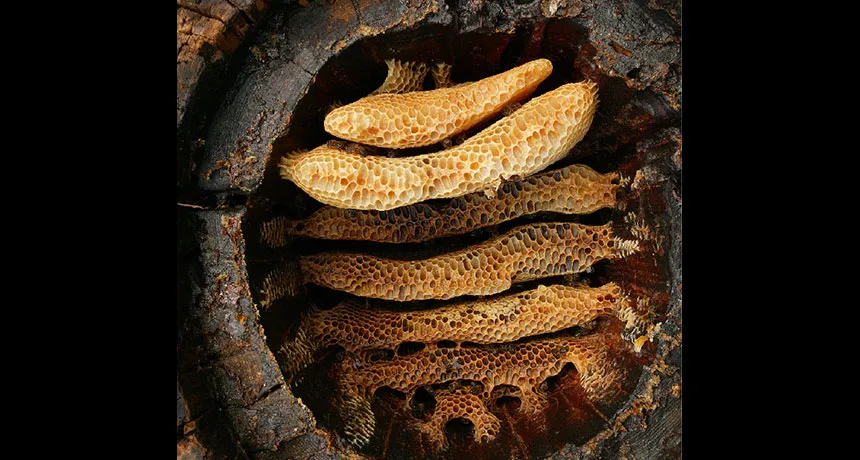Honeybees sweetened early farmers’ lives
Chemical traces on pottery point to widespread use of honey and wax as early as 9,000 years ago

BEE STORY A hollow log in France holds layers of honeycombs. Ancient farmers in Southwest Asia and Europe sought beeswax and probably honey from sweet spots like this, a chemical analysis of pottery pieces between 9,000- and 5,000-years-old suggests.
Eric Tourneret
Here’s the latest buzz on ancient farmers in Southwest Asia and Europe — they were big into honeybees.
Farmers spreading west across that wide swath of territory acquired beeswax and probably consumed honey around 9,000 to 5,000 years ago, say biogeochemist Mélanie Roffet-Salque of the University of Bristol in England and her colleagues. Fragments of organic material clinging to pottery from early farming sites display a chemical signature typical of beeswax, the scientists report in the Nov. 12 Nature.
The new study is the largest analysis of chemical residues on pottery to date and the first to document the widespread use of bee products among ancient farmers, says bioarchaeologist Oliver Craig of the University of York in England, who did not participate in the study.
It’s still unclear how early farmers acquired beeswax and presumably honey, Roffet-Salque says. “We have shown that these farmers were exploiting bee products, but we cannot really tell if it was a result of honey hunting or beekeeping,” she says.
Humans probably didn’t control honeybees to a large-enough extent to domesticate the insects until “well after” 4,000 years ago, says bioarchaeologist Greger Larson of the University of Oxford. Remains of a large, 3,000-year-old beekeeping facility have been found in Israel (SN: 9/27/08, p. 11). Depictions of small-scale beekeeping in ancient Egypt date to as early as 4,400 years ago.
Evidence of honey hunting spans an even broader time period. Rock art in Spain that may be as old as 10,000 years portrays two men climbing a rope ladder with sacks to collect honey and honeycombs from a wild hive. Present-day hunter-gatherers living in warm regions routinely collect honey from wild hives, often making fires to smoke out bees and avoid getting stung, a team led by anthropologist Frank Marlowe of the University of Cambridge reported in the June 2014 Journal of Human Evolution.
“Bee hives probably attracted even our very distant ancestors,” Craig says.
Roffet-Salque’s group analyzed more than 6,400 pottery vessels from 154 farming sites. The most abundant evidence of beeswax appeared on pottery sherds from the Balkan Peninsula, including Greece and the Aegean Islands. Of 1,915 pottery pieces found there dating to between around 7,800 to 5,000 years ago, about two dozen yielded beeswax residue.
Evidence of beeswax also turned up on a 7,000- to 6,000-year-old pottery fragment from an Algerian site. This is the first evidence of honeybee exploitation by ancient North African animal herders.
Two vessels from a farming site in eastern Turkey contained the oldest confirmed beeswax remains, dating back some 8,500 years.
Early farmers and herders may have used honey in cooking, leaving behind beeswax residue on pottery, the researchers say. Vessels may have also been used to boil down wax honeycombs so wax could be used for ritual, medical or other purposes. A 6,500-year-old human jaw from Slovenia in southern Central Europe contains a tooth with a beeswax filling.
No chemical signs of beeswax appeared on pottery from ancient farming sites north of Denmark, including Scotland and southern Scandinavia. Cold conditions in Europe’s far north at that time were unsuitable for honeybees, the researchers suspect.
Previous chemical studies of farmers’ pottery, directed by University of Bristol biogeochemist and study coauthor Richard Evershed, revealed comparably ancient milk and cheese consumption in Europe and North Africa (SN: 1/26/13, p. 16).
Editor’s Note: This story was updated November 20, 2015, to correct the number of pottery pieces found with beeswax residue, the range of dates for those pieces and the approximate date of the oldest beeswax remains.







